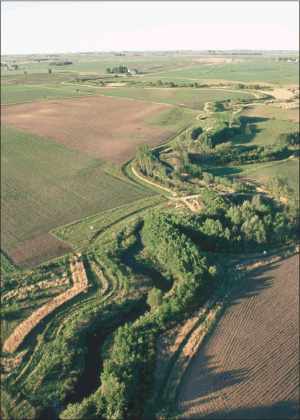Green Horizons
Volume 19, Number 2Spring 2015
The role of the DNR: Reducing Nonpoint Source Pollution in our Missouri Water
ROBERT STOUT | Missouri DNR
 |
Photo courtesy of Dick Schultz, Iowa State |
An agroforestry riparian buffer offers both financial gain and ecosystem services. |
The Missouri Department of Natural Resources (department) is the agency in Missouri responsible for protecting Missouri's air, land and water. The department's responsibility is to keep pollution out of Missouri's water. We have made strides in reducing pollution from permitted sources, but nonpoint source pollution offers significant challenges.
When we hear the terms point source and nonpoint source pollution, what do these terms mean? We call the wastewater that is discharged from a facility, such as a sewage treatment plant or the discharge from a power plant or industrial facility, point source pollution. It is usually a regulated discharge from a treatment system that must meet the conditions spelled out in a Missouri State Operating Permit. Nonpoint source pollution, in contrast, is untreated pollution that generally cannot be traced back to a single source. We rely on voluntary efforts to address this type of pollution. Often, nonpoint source pollution can be traced to multiple sources (both natural and manmade) within a watershed, such as storm water runoff, agricultural/land disturbance activities, or faulty septic systems. It is critical that we understand that we collectively influence nonpoint source pollution and what we can do about it.
Nonpoint source pollution is responsible for most of the water quality impairments in the United States. Nonpoint source pollution occurs as rainfall, snowmelt, or irrigation that runs over land or through the ground and picks up pollutants such as nutrients, road salt, and sediments. These pollutants are then deposited into rivers, lakes, and coastal waters or introduced into ground water, resulting in ecological impairments to aquatic ecosystems. Nonpoint source pollution is widespread and associated with numerous activities, including agriculture, forestry, grazing, septic systems, recreational boating, urban runoff, and construction.
The department has begun to look at the problems of water pollution through a watershed-based approach that we call Our Missouri Waters. Watersheds are drainage basins. They are systems that are influenced by the people who live and work in them. Pollution in a watershed affects where we can fish and swim, how clean our drinking water is, and whether we have sufficient clean water for agriculture and industry. The department understands that our role is to provide technical information, listen to our citizens input and priorities and help provide solutions to address those priorities. Local participation and partnerships are the keys to successfully addressing these problems. When we understand the problems, we can identify the resources and actions that can be taken to successfully address them.
There are many actions that can help reduce nonpoint source pollution:
- We can use best management practices in our work and home activities.
- We can install rain gardens and bioretention and infiltration basins to reduce runoff.
- We can maintain riparian buffers to help filter pollutants and reduce erosion.
- We can institute planned grazing and watering practices.
- We can create wetlands to capture and treat pollutants.
- We can follow good nutrient management strategies.
All of these activities can contribute to significant reductions of sediment and nutrients.
The department has several programs that can provide technical and financial help to citizens and partners who want to address these problems. The department's Soil and Water Conservation Program operates a cost-share program, which provides incentives for landowners to install conservation practices that prevent or control excessive erosion and protect water quality. Landowners can receive up to 75 percent of the estimated cost of the approved practices they install. Promoting good farming and forestry techniques keeps soil on the fields and waters clean. The program helps conserve the productivity of Missouri's working lands. This effort is funded through the one-tenth cent Parks, Soils and Water sales tax.
The department also uses federal funds provided under Section 319(h) of the federal Clean Water Act to support voluntary, watershed-based efforts to reduce nonpoint sources of pollution.
In addition to the department's efforts, other agencies such as the USDA Natural Resources Conservation Service and the Missouri Department of Conservation as well as many non-profit groups, organizations and partners offer resources to assist in reducing nonpoint source pollution.
In the final analysis, keeping Our Missouri Waters clean requires everyone's commitment and efforts. Because we want to leave the legacy of a clean environment to the next generation, what we do now matters.